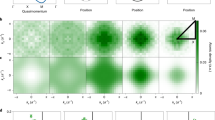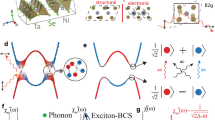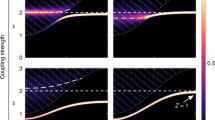Abstract
A long-standing open problem in condensed-matter physics is whether or not a strongly disordered interacting insulator can be mapped to a system of effectively non-interacting localized excitations. Using terahertz two-dimensional coherent spectroscopy, we investigate this issue in phosphorus-doped silicon, a classic example of a correlated disordered electron system in three dimensions. Despite the intrinsically disordered nature of these materials, we observe coherent excitations and strong photon echoes that provide us with a powerful method for the study of their decay processes. We extract the energy relaxation and decoherence rates close to the metal–insulator transition. We observe that both rates are linear in excitation frequency with a slope close to unity. The energy relaxation timescale counterintuitively increases with increasing temperature, and the coherence relaxation timescale has little temperature dependence below 25 K, but increases as the material is doped towards the metal–insulator transition. Here we argue that these features imply that the system behaves as a well-isolated electronic system on the timescales of interest, and relaxation is controlled by electron–electron interactions. Our observations constitute a distinct phenomenology, driven by the interplay of strong disorder and strong electron–electron interactions, which we dub the marginal Fermi glass.
This is a preview of subscription content, access via your institution
Access options
Access Nature and 54 other Nature Portfolio journals
Get Nature+, our best-value online-access subscription
$29.99 / 30 days
cancel any time
Subscribe to this journal
Receive 12 print issues and online access
$209.00 per year
only $17.42 per issue
Buy this article
- Purchase on Springer Link
- Instant access to full article PDF
Prices may be subject to local taxes which are calculated during checkout




Similar content being viewed by others
Data availability
All data that support the plots within this paper and other findings of this study are available from the corresponding author upon reasonable request.
References
Nozieres, P. Theory of Quantum Liquids (CRC Press, 2018).
Anderson, P. W. Absence of diffusion in certain random lattices. Phys. Rev. 109, 1492–1505 (1958).
Abrahams, E. 50 Years of Anderson Localization (World Scientific, 2010).
Anderson, P. W. The Fermi Glass: Theory and Experiment (World Scientific, 2004).
Efros, A. L. & Shklovskii, B. I. Coulomb gap and low temperature conductivity of disordered systems. J. Phys. C 8, L49–L51 (1975).
Fleishman, L. & Anderson, P. Interactions and the Anderson transition. Phys. Rev. B 21, 2366–2377 (1980).
Freedman, R. & Hertz, J. Theory of a Fermi glass. Phys. Rev. B 15, 2384–2398 (1977).
Gornyi, I. V., Mirlin, A. D. & Polyakov, D. G. Interacting electrons in disordered wires: Anderson localization and low-T transport. Phys. Rev. Lett. 95, 206603 (2005).
Basko, D. M., Aleiner, I. L. & Altshuler, B. L. Metal–insulator transition in a weakly interacting many-electron system with localized single-particle states. Ann. Phys. 321, 1126–1205 (2006).
Nandkishore, R. & Huse, D. A. Many-body localization and thermalization in quantum statistical mechanics. Annu. Rev. Condens. Matter Phys. 6, 15–38 (2015).
Abanin, D. A., Altman, E., Bloch, I. & Serbyn, M. Colloquium: many-body localization, thermalization and entanglement. Rev. Mod. Phys. 91, 021001 (2019).
Burin, A. L., Kagan, Y., Maksimov, L. A. & Polishchuk, I. Y. Dephasing rate in dielectric glasses at ultralow temperatures. Phys. Rev. Lett. 80, 2945–2948 (1998).
Burin, A. L. Energy delocalization in strongly disordered systems induced by the long-range many-body interaction. Preprint at https://arxiv.org/pdf/cond-mat/0611387.pdf (2006).
Yao, N. Y. et al. Many-body localization in dipolar systems. Phys. Rev. Lett. 113, 243002 (2014).
Gutman, D. B. et al. Energy transport in the Anderson insulator. Phys. Rev. B 93, 245427 (2016).
Nandkishore, R. M. & Sondhi, S. L. Many-body localization with long-range interactions. Phys. Rev. X 7, 041021 (2017).
Woerner, M., Kuehn, W., Bowlan, P., Reimann, K. & Elsaesser, T. Ultrafast two-dimensional terahertz spectroscopy of elementary excitations in solids. New J. Phys. 15, 025039 (2013).
Lu, J. et al. Coherent two-dimensional terahertz magnetic resonance spectroscopy of collective spin waves. Phys. Rev. Lett. 118, 207204 (2017).
Wan, Y. & Armitage, N. Resolving continua of fractional excitations by spinon echo in THz 2D coherent spectroscopy. Phys. Rev. Lett. 122, 257401 (2019).
Rosenbaum, T. et al. Metal–insulator transition in a doped semiconductor. Phys. Rev. B 27, 7509–7523 (1983).
Paalanen, M., Rosenbaum, T., Thomas, G. & Bhatt, R. N. Critical scaling of the conductance in a disordered insulator. Phys. Rev. Lett. 51, 1896–1899 (1983).
Helgren, E., Armitage, N. P. & Grüner, G. Frequency-dependent conductivity of electron glasses. Phys. Rev. B 69, 014201 (2004).
Helgren, E., Armitage, N. P. & Grüner, G. Electrodynamics of a Coulomb glass in n-type silicon. Phys. Rev. Lett. 89, 246601 (2002).
Lee, M. & Stutzmann, M. L. Microwave ac conductivity spectrum of a Coulomb glass. Phys. Rev. Lett. 87, 056402 (2001).
Shklovskii, B. & Efros, A. Phononless hopping conduction in disordered systems. Zh. Eksp. Theor. Fiz. 81, 406–415 (1981).
Mukamel, S. Principles of Nonlinear Optical Spectroscopy (Oxford Univ. Press, 1995).
Hamm, P. & Zanni, M. Concepts and Methods of 2D Infrared Spectroscopy (Cambridge Univ. Press, 2011).
Aue, W., Bartholdi, E. & Ernst, R. R. Two-dimensional spectroscopy. Application to nuclear magnetic resonance. J. Chem. Phys. 64, 2229–2246 (1976).
Cundiff, S. T. & Mukamel, S. Optical multidimensional coherent spectroscopy. Phys. Today 66, 44–49 (2013).
Kuehn, W., Reimann, K., Woerner, M., Elsaesser, T. & Hey, R. Two-dimensional terahertz correlation spectra of electronic excitations in semiconductor quantum wells. J. Phys. Chem. B 115, 5448–5455 (2011).
Lu, J. et al. Nonlinear two-dimensional terahertz photon echo and rotational spectroscopy in the gas phase. Proc. Natl Acad. Sci. USA 113, 11800–11805 (2016).
Choi, W., Lee, K. H. & Kim, Y. B. Theory of two-dimensional nonlinear spectroscopy for the Kitaev spin liquid. Phys. Rev. Lett. 124, 117205 (2020).
Tomakoff, A. Nonlinear and Two-Dimensional Spectroscopy (Univ. Chicago, 2011); http://tdqms.uchicago.edu/page/nonlinear-and-two-dimensional-spectroscopy-notes
Galperin, Y., Gurevich, V. & Parshin, D. in Hopping Transport in Solids (eds Pollak, M. & Shklovskii, B) Ch. 3, 81–123 (Modern Problems in Condensed Matter Sciences Vol. 28, Elsevier, 1991).
Bhatt, R. N. & Lee, P. A. Scaling studies of highly disordered spin-1/2 antiferromagnetic systems. Phys. Rev. Lett. 48, 344–347 (1982).
Fisher, M. P. A. & Zwerger, W. Quantum Brownian motion in a periodic potential. Phys. Rev. B 32, 6190–6206 (1985).
Varma, C., Nussinov, Z. & van Saarloos, W. Singular or non-Fermi liquids. Phys. Rep. 361, 267–417 (2002).
Varma, C., Littlewood, P. B., Schmitt-Rink, S., Abrahams, E. & Ruckenstein, A. Phenomenology of the normal state of Cu–O high-temperature superconductors. Phys. Rev. Lett. 63, 1996–1999 (1989).
Burin, A. & Kagan, Y. Low-energy collective excitations in glasses. New relaxation mechanism for ultralow temperatures. Zh. Eksp. Teor. Fiz. 106, 633–647 (1994).
Levitov, L. S. Absence of localization of vibrational modes due to dipole–dipole interaction. Europhys. Lett. 9, 83–86 (1989).
Parameswaran, S. A. & Gopalakrishnan, S. Non-Fermi glasses: localized descendants of fractionalized metals. Phys. Rev. Lett. 119, 146601 (2017).
Thorsmølle, V. & Armitage, N. Ultrafast (but many-body) relaxation in a low-density electron glass. Phys. Rev. Lett. 105, 086601 (2010).
Greenland, P. et al. Coherent control of Rydberg states in silicon. Nature 465, 1057–1061 (2010).
Lynch, S. A. et al. First observation of a THz photon echo. In 35th International Conference on Infrared, Millimeter and Terahertz Waves 1–2 (IEEE, 2010).
Thurber, W. R., Mattis, R. L., Liu, Y. M. & Filliben, J. J. Resistivity-dopant density relationship for phosphorus-doped silicon. J. Electrochem. Soc. 127, 1807–1812 (1980).
Acknowledgements
We thank A. Burin, Y. Galperin, Y.-B. Kim, A. Legros, I. Martin, A. Millis, V. Oganesyan, S. Paramesweran, B. Shklovskii and Y. Yuan for helpful discussions. This project was supported by a now-cancelled DARPA DRINQS programme grant and by the Gordon and Betty Moore Foundation, EPiQS initiative, grant number GBMF-9454. S.G. acknowledges support from NSF grant no. DMR-1653271.
Author information
Authors and Affiliations
Contributions
F.M. and D.C. built the 2D terahertz set-up and carried out experiments and analysis. S.G. and R.N. provided theoretical support. N.P.A. directed the project. All authors contributed to the writing and editing of the manuscript.
Corresponding authors
Ethics declarations
Competing interests
The authors declare no competing interests.
Additional information
Peer review information Nature Physics thanks the anonymous reviewers for their contribution to the peer review of this work.
Publisher’s note Springer Nature remains neutral with regard to jurisdictional claims in published maps and institutional affiliations.
Supplementary information
Supplementary Information
Supplementary Sections I–IV and Figs. 1–10.
Rights and permissions
About this article
Cite this article
Mahmood, F., Chaudhuri, D., Gopalakrishnan, S. et al. Observation of a marginal Fermi glass. Nat. Phys. 17, 627–631 (2021). https://doi.org/10.1038/s41567-020-01149-0
Received:
Accepted:
Published:
Issue Date:
DOI: https://doi.org/10.1038/s41567-020-01149-0
This article is cited by
-
Terahertz-field-driven magnon upconversion in an antiferromagnet
Nature Physics (2024)
-
Unconventional room-temperature carriers in the triangular-lattice Mott insulator TbInO3
Nature Physics (2023)
-
Observation of an exotic insulator to insulator transition upon electron doping the Mott insulator CeMnAsO
Nature Communications (2023)
-
Quantum coherence tomography of light-controlled superconductivity
Nature Physics (2022)
-
When silicon is like a cuprate
Nature Physics (2021)



